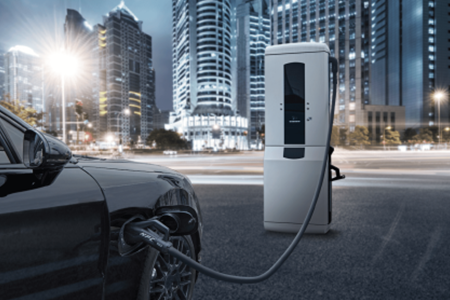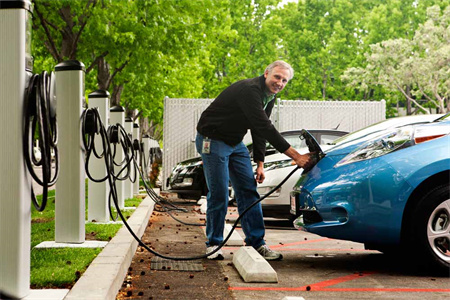While most of the charging demand is currently met by home charging, publicly accessible chargers are increasingly needed in order to provide the same level of convenience and accessibility as for refuelling conventional vehicles. In dense urban areas, in particular, where access to home charging is more limited, public charging infrastructure is a key enabler for EV adoption. At the end of 2022, there were 2.7 million public charging points worldwide, more than 900 000 of which were installed in 2022, about a 55% increase on 2021 stock, and comparable to the pre-pandemic growth rate of 50% between 2015 and 2019.
Slow chargers
Globally, more than 600 000 public slow charging points1 were installed in 2022, 360 000 of which were in China, bringing the stock of slow chargers in the country to more than 1 million. At the end of 2022, China was home to more than half of the global stock of public slow chargers.
Europe ranks second, with 460 000 total slow chargers in 2022, a 50% increase from the previous year. The Netherlands leads in Europe with 117 000, followed by around 74 000 in France and 64 000 in Germany. The stock of slow chargers in the United States increased by 9% in 2022, the lowest growth rate among major markets. In Korea, slow charging stock has doubled year-on-year, reaching 184 000 charging points.
Fast chargers
Publicly accessible fast chargers, especially those located along motorways, enable longer journeys and can address range anxiety, a barrier to EV adoption. Like slow chargers, public fast chargers also provide charging solutions to consumers who do not have reliable access to private charging, thereby encouraging EV adoption across wider swaths of the population. The number of fast chargers increased by 330 000 globally in 2022, though again the majority (almost 90%) of the growth came from China. The deployment of fast charging compensates for the lack of access to home chargers in densely populated cities and supports China’s goals for rapid EV deployment. China accounts for total of 760 000 fast chargers, but more than of the total public fast charging pile stock is situated in just ten provinces.
In Europe the overall fast charger stock numbered over 70 000 by the end of 2022, an increase of around 55% compared to 2021. The countries with the largest fast charger stock are Germany (over 12 000), France (9 700) and Norway (9 000). There is a clear ambition across the European Union to further develop the public charging infrastructure, as indicated by provisional agreement on the proposed Alternative Fuels Infrastructure Regulation (AFIR), which will set electric charging coverage requirements across the trans-European network-transport (TEN-T) between the European Investment Bank and the European Commission will make over EUR 1.5 billion available by the end of 2023 for alternative fuels infrastructure, including electric fast charging.
The United States installed 6 300 fast chargers in 2022, about three-quarters of which were Tesla Superchargers. The total stock of fast chargers reached 28 000 at the end of 2022. Deployment is expected to accelerate in the coming years following government approval of the (NEVI). All US states, Washington DC, and Puerto Rico are participating in the programme, and have already been allocated USD 885 million in funding for 2023 to support the build-out of chargers across 122 000 km of highway . The US Federal Highway Administration has announced new national standards for federally funded EV chargers to ensure consistency, reliability, accessibility and compatibility. of the new standards, Tesla has announced it will open a portion of its US Supercharger (where Superchargers represent 60% of the total stock of fast chargers in the United States) and Destination Charger network to non-Tesla EVs.
Public charging points are increasingly necessary to enable wider EV uptake
Deployment of public charging infrastructure in anticipation of growth in EV sales is critical for widespread EV adoption. In Norway, for example, there were around 1.3 battery electric LDVs per public charging point in 2011, which supported further adoption. At the end of 2022, with over 17% of LDVs being BEVs, there were 25 BEVs per public charging point in Norway. In general, as the stock share of battery electric LDVs increases, the charging point per BEV ratio decreases. Growth in EV sales can only be sustained if charging demand is met by accessible and affordable infrastructure, either through private charging in homes or at work, or publicly accessible charging stations.
Ratio of electric LDVs per public charger
Public charging point per battery-electric LDV ratio in selected countries against battery electric LDV stock share
While PHEVs are less reliant on public charging infrastructure than BEVs, policy-making relating to the sufficient availability of charging points should incorporate (and encourage) public PHEV charging. If the total number of electric LDVs per charging point is considered, the global average in 2022 was about ten EVs per charger. Countries such as China, Korea and the Netherlands have maintained fewer than ten EVs per charger throughout past years. In countries that rely heavily on public charging, the number of publicly accessible chargers has been expanding at a speed that largely matches EV deployment.
However, in some markets characterised by widespread availability of home charging (due to a high share of single-family homes with the opportunity to install a charger) the number of EVs per public charging point can be even higher. For example, in the United States, the ratio of EVs per charger is 24, and in Norway is more than 30. As the market penetration of EVs increases, public charging becomes increasingly important, even in these countries, to support EV adoption among drivers who do not have access to private home or workplace charging options. However, the optimal ratio of EVs per charger will differ based on local conditions and driver needs.
Perhaps more important than the number of public chargers available is the total public charging power capacity per EV, given that fast chargers can serve more EVs than slow chargers. During the early stages of EV adoption, it makes sense for available charging power per EV to be high, assuming that charger utilisation will be relatively low until the market matures and the utilisation of infrastructure becomes more efficient. In line with this, the European Union’s on the AFIR includes requirements for the total power capacity to be provided based on the size of the registered fleet.
Globally, the average public charging power capacity per electric LDV is around 2.4 kW per EV. In the European Union, the ratio is lower, with an average around 1.2 kW per EV. Korea has the highest ratio at 7 kW per EV, even with most public chargers (90%) being slow chargers.
Number of electric LDVs per public charging point and kW per electric LDV, 2022
Number of electric LDVs per charging pointkW of public charging per electric LDVsNew ZealandIcelandAustraliaNorwayBrazilGermanySwedenUnited StatesDenmarkPortugalUnited KingdomSpainCanadaIndonesiaFinlandSwitzerlandJapanThailandEuropean UnionFrancePolandMexicoBelgiumWorldItalyChinaIndiaSouth AfricaChileGreeceNetherlandsKorea08162432404856647280889610400.61.21.82.433.64.24.85.466.67.27.8
- EV / EVSE (bottom axis)
- kW / EV (top axis)
In the regions where electric trucks are becoming commercially available, battery electric trucks can compete on a TCO basis with conventional diesel trucks for a growing range of operations, not only urban and regional, but also in the tractor-trailer regional and long-haul segments. Three parameters that determine the time at which is reached are tolls; fuel and operations costs (e.g. the difference between diesel and electricity prices faced by truck operators, and reduced maintenance costs); and CAPEX subsidies to reduce the gap in the upfront vehicle purchase price. Since electric trucks can provide the same operations with lower lifetime costs (including if a discounted rate is applied), the in which vehicle owners expect to recuperate upfront costs is a key factor in determining whether to purchase an electric or conventional truck.
The economics for electric trucks in long-distance applications can be substantially improved if charging costs can be reduced by maximising “off-shift” (e.g. night-time or other longer periods of downtime) slow charging, securing bulk purchase contracts with grid operators for “mid-shift” (e.g. during breaks), fast (up to 350 kW), or ultra-fast (>350 kW) charging, and exploring smart charging and vehicle-to-grid opportunities for extra income.
Electric trucks and buses will rely on off-shift charging for the majority of their energy. This will be largely achieved at private or semi-private charging depots or at public stations on highways, and often overnight. Depots to service growing demand for heavy-duty electrification will need to be developed, and in many cases may require distribution and transmission grid upgrades. Depending on vehicle range requirements, depot charging will be sufficient to cover most operations in urban bus as well as urban and regional truck operations.
Regulations that mandate rest periods can also provide a time window for mid-shift charging if fast or ultra-fast charging options are available en route: the European Union requires 45 minutes of break after every 4.5 hours of driving; the United States mandates 30 minutes after 8 hours.
Most commercially available direct current (DC) fast charging stations currently enable power levels ranging from 250-350 kW. reached by the European Council and Parliament includes a gradual process of infrastructure deployment for electric heavy-duty vehicles starting in 2025. Recent studies of power requirements for regional and long-haul truck operations in the US and Europe find that charging power higher than 350 kW, and as high as 1 MW, may be required to fully recharge electric trucks during a 30- to 45-minute break.
Recognising the need to scale up fast or ultra-fast charging as a prerequisite for making both regional and, in particular, long-haul operations technically and economically viable, in 2022 Traton, Volvo, and Daimler established an independent joint venture, With EUR 500 million in collective investments from the three heavy-duty manufacturing groups, the initiative aims to deploy more than 1 700 fast (300 to 350 kW) and ultra-fast (1 MW) charging points across Europe.
Multiple charging standards are currently in use, and technical specifications for ultra-fast charging are under development. Ensuring maximum possible convergence of charging standards and interoperability for heavy-duty EVs will be needed to avoid the cost, inefficiency, and challenges for vehicle importers and international operators that would be created by manufacturers following divergent paths.
In China, co-developers China Electricity Council and CHAdeMO’s “ultra ChaoJi” are developing a charging standard for heavy-duty electric vehicles for up to several megawatts. In Europe and the United States, specifications for the CharIN Megawatt Charging System (MCS), with a potential maximum power of. are under development by the International Organization for Standardization (ISO) and other organisations. The final MCS specifications, which will be needed for commercial roll-out, are expected for 2024. After the first megawatt charging site offered by Daimler Trucks and Portland General Electric (PGE) in 2021, as well as investments and projects in Austria, Sweden, Spain and the United Kingdom.
Commercialisation of chargers with rated power of 1 MW will require significant investment, as stations with such high-power needs will incur significant costs in both installation and grid upgrades. Revising public electric utility business models and power sector regulations, co-ordinating planning across stakeholders and smart charging can all help Direct support through pilot projects and financial incentives can also accelerate demonstration and adoption in the early stages. A recent study outlines some key design considertation for developing MCS rated charging stations:
- Planning charging stations at highway depot locations near transmission lines and substations can be an optimal solution for minimising costs and increasing charger utilisation.
- “Right-sizing” connections with direct connections to transmission lines at an early stage, thereby anticipating the energy needs of a system in which high shares of freight activity have been electrified, rather than upgrading distribution grids on an ad-hoc and short-term basis, will be critical to reduce costs. This will require structured and co-ordinated planning between grid operators and charging infrastructure developers across sectors.
- Since transmission system interconnections and grid upgrades can take 4-8 years, siting and construction of high-priority charging stations will need to begin as soon as possible.
Solutions include installing stationary storage and integrating local renewable capacity, combined with smart charging, which can help reduce both infrastructure costs related to grid connection and electricity procurement costs (e.g. by enabling truck operators to minimise cost by arbitraging price variability throughout the day, taking advantage of vehicle-to-grid opportunities, etc.).
Other options to provide power to electric heavy-duty vehicles (HDVs) are battery swapping and electric road systems. Electric road systems can transfer power to a truck either via inductive coils in a road, or through conductive connections between the vehicle and road, or via catenary (overhead) lines. Catenary and other dynamic charging options may hold promise for reducing university of system-level costs in the transition to zero-emission regional and long-haul trucks, completing favourably in terms of total capital and operating costs. They can also help to reduce battery capacity needs. Battery demand can be further reduced, and utilisation further improved, if electric road systems are designed to be compatible not only with trucks but also electric cars. However, such approaches would require inductive or in-road designs that come with greater hurdles in terms of technology development and design, and are more capital intensive. At the same time, electric road systems pose significant challenges resembling those of the rail sector, including a greater need for standardisation of paths and vehicles (as illustrated with trams and trolley buses), compatibility across borders for long-haul trips, and appropriate infrastructure ownership models. They provide less flexibility for truck owners in terms of routes and vehicle types, and have high development costs overall, all affecting their competitiveness relative to regular charging stations. Given these challenges, such systems would most effectively be deployed first on heavily used freight corridors, which would entail close co-ordination across various public and private stakeholders. Demonstrations on public roads to date in Germany and Sweden have relied on champions from both private and public entities. Calls for electric road system pilots are also being considered in the China, India, the UK and the United States.
Charging needs for heavy-duty vehicles
International Council on Clean Transportation (ICCT) analysis suggests that battery swapping for electric two-wheelers in taxi services (e.g. bike taxis) offers the most competitive TCO compared to point charging BEV or ICE two-wheelers. In the case of last-mile delivery via a two-wheeler, point charging currently has a TCO advantage over battery swapping, but with the right policy incentives and scale, swapping could become a viable option under certain conditions. In general, as the average daily distance travelled increases, the battery electric two-wheeler with battery swapping becomes more economical than point charging or gasoline vehicles. In 2021, theSwappable Batteries Motorcycle Consortium was founded with the aim to facilitate battery swapping of light-weight vehicles, including two/three-wheelers, by working together on common battery specifications.
Battery swapping of electric two/three-wheelers is particularly gaining momentum in India. There are currently over ten different companies in the Indian market, including Gogoro, a Chinese Taipei-based electric scooter and battery swapping technology leader. Gogoro claims its batteries power 90% of electric scooters in Chinese Taipei, and the Gogoro network has more than 12 000 battery swapping stations to support over 500 000 electric two-wheelers across nine countries, mostly in the Asia Pacific region.Gogoro has now formed a partnership with India-based Zypp Electric,, which runs an EV-as-a-service platform for last-mile deliveries; together, they are deploying 6 battery swapping stations and 100 electric two-wheelers as part of a pilot project for business-to-business last-mile delivery operations in the city of Delhi. At the beginning of 2023, they raised ,which they will use to expand their fleet to 200 000 electric two-wheelers across 30 Indian cities by 2025. Sun Mobility has a longer history of battery swapping in India, with over swapping stations across the country for electric two- and three-wheelers, including e-rickshaws, with partners such as Amazon India. Thailand is also seeing in battery swapping services for motorcycle taxi and delivery drivers.
While most prevalent in Asia, battery swapping for electric two-wheelers is also spreading to Africa. For example, Rwandan electric motorbike start-up operates battery swap stations, with a focus on serving motorcycle taxi operations that require long daily ranges. Ampersand has built ten battery swap stations in Kigali and three in Nairobi, Kenya. These stations perform close to37 000 battery swaps a month.
Battery swapping for two/three-wheelers offers cost advantages
For trucks in particular, battery swapping can have major advantages over ultra-fast charging. Firstly, swapping can take as little, which would be difficult and expensive to achieve through cable-based charging, requiring an ultra-fast charger connected to medium- to high-voltage grids and expensive battery management systems and battery chemistries. Avoiding ultra-fast charging can also extend battery capacity, performance and cycle life.
Battery-as-a-service (BaaS), separating the purchase of the truck and the battery, and establishing a lease contract for the battery, substantially reduces the upfront purchase cost. In addition, since trucks tend to depend on lithium iron phosphate (LFP) battery chemistries, which are more durable than lithium nickel manganese cobalt oxide (NMC) batteries, they are well-suited for swapping in terms of safety and affordability.
However, the cost of building a station will likely be higher for truck battery swapping given the larger vehicle size and heavier batteries, which require more space and specialised equipment to perform the swap. Another major barrier is the requirement that batteries be standardised to a given size and capacity, which truck OEMs are likely to perceive as a challenge to competitiveness as battery design and capacity is a key differentiator among electric truck manufacturers.
China is at the forefront of battery swapping for trucks due to significant policy support and use of technology designed to complement cable charging. In 2021, China’s MIIT announced that a number of cities would pilot battery swapping technology, including HDV battery swapping in three cities. Almost all major Chinese heavy truck manufacturers, including FAW, CAMC, Dongfeng, Jiangling Motors Corporation Limited (JMC), Shanxi Automobile, and SAIC.
China is at the forefront of battery swapping for trucks
China is also the leader in battery swapping for passenger cars. Across all modes, the total number of battery swapping stations in China stood at almost at the end of 2022, 50% higher than at the end of 2021. NIO, which produces battery swapping-enabled cars and the supporting swapping stations, runs more than in China, reporting that the network covers more than two-thirds of mainland China. Half of their swapping stations were installed in 2022, and the company has set a target of 4 000 battery swap stations globally by 2025. The company their swap stations can perform over 300 swaps per day, charging up to 13 batteries concurrently at a power of 20-80 kW.
NIO also announced plans to build battery swap stations in Europe as their battery swapping-enabled car models became available in European markets towards the end of 2022. The first NIO battery swap station in Sweden was opened in and by the end of 2022, ten NIO battery swap stations had been opened across Norway, Germany, Sweden and the Netherlands. In contrast to NIO, whose swapping stations service NIO cars, the Chinese battery swapping station operator Aulton’s stations support 30 models from 16 different vehicle companies.
Battery swapping could also be a particularly attractive option for LDV taxi fleets, whose operations are more sensitive to recharging times than personal cars. US start-up Ample currently operates 12 battery swapping stations in the San Francisco Bay area, mainly serving Uber rideshare vehicles.
China is also the leader in battery swapping for passenger cars
References
Slow chargers have power ratings less than or equal to 22 kW. Fast chargers are those with a power rating of more than 22 kW and up to 350 kW. “Charging points” and “chargers” are used interchangeably and refer to the individual charging sockets, reflecting the number of EVs that can charge at the same time. ‘’Charging stations” may have multiple charging points.
Previously a directive, the proposed AFIR, once formally approved, would become a binding legislative act, stipulating, among other things, a maximum distance between chargers installed along the TEN-T, the primary and secondary roads within the European Union.
Inductive solutions are further from commercialisation and face challenges to deliver sufficient power at highway speeds.
Post time: Nov-20-2023

 Portable EV Charger
Portable EV Charger Home EV Wallbox
Home EV Wallbox DC Charger Station
DC Charger Station EV Charging Module
EV Charging Module NACS&CCS1&CCS2
NACS&CCS1&CCS2 EV Accessories
EV Accessories


